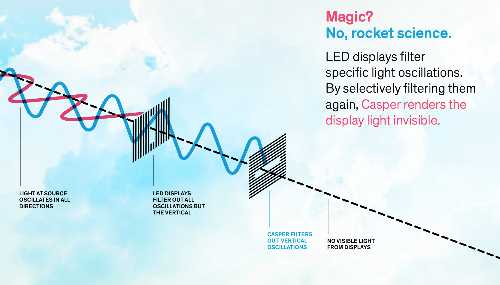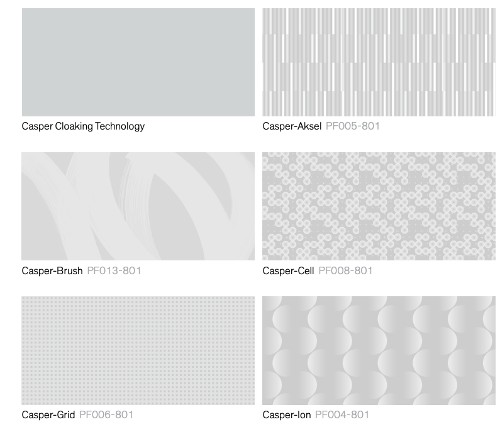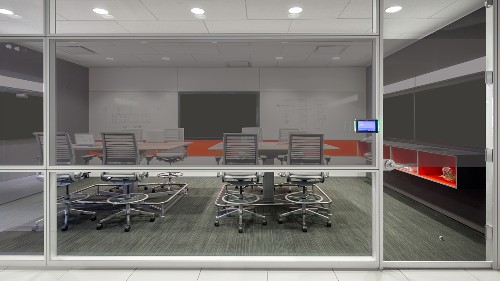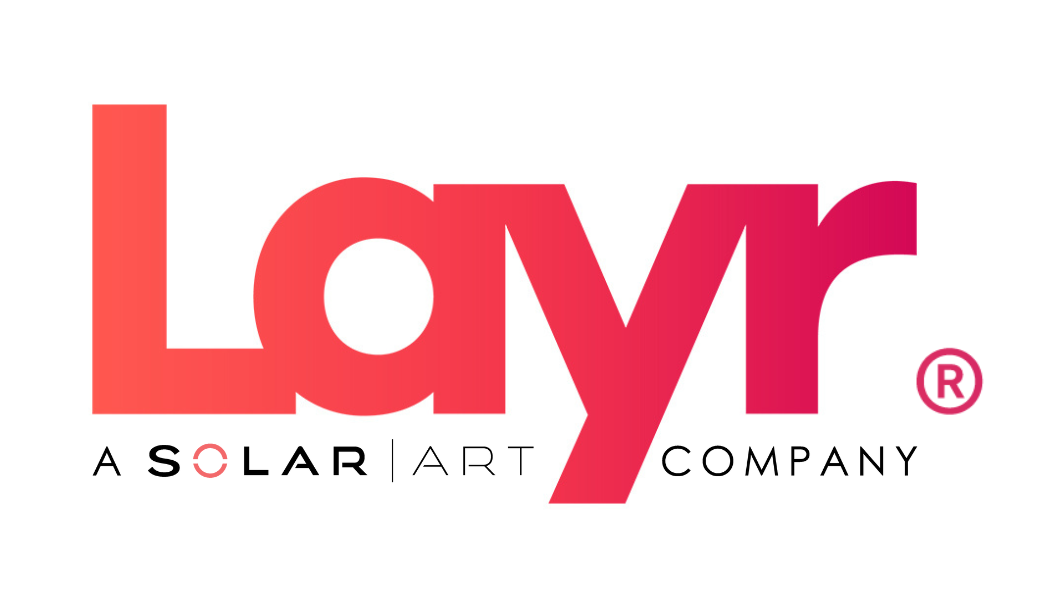Meet Casper
Looking for the answer to your open office privacy concerns? Meet Casper Cloaking Film from Designtex. Casper blacks out LED displays to people outside the room. Those outsiders can see people and objects inside, but no privileged digital information.
Though privacy screens for laptops and phones have existed for some time, Casper is revolutionary. With Casper, architects have a ready made solution to digital privacy in an open office. By installing Casper, business strike a perfect balance between openness and privacy. Collaboration can go on without the threat of visual hacking.
See Casper Window Film at work in a recent installation by Layr at a New York Office:
In this post, we’ll tell you everything you need to know about this sophisticated technology. We’ll take you through answers to the following questions:
- How does Casper Cloaking work?
- What does Casper look like?
- What industries use Casper?
- How much does Casper cost to install?
- How is Casper installed?
- Is Casper worth it?
- What else should I know about Casper Technology?
If you finish this post and have questions or would like to talk to our experts about installation, don’t hesitate to contact us.
How Does Casper Cloaking Film Work?
Casper Cloaking technology uses physics and optics to black out LED displays. Admittedly, it’s complex, but we can walk you through the basics.
Let’s use a scenario with a glass-walled conference room, one of our most common use cases. In this case, we apply Casper to the glass on the inside of the room.
The easiest way to understand how Casper works is to imagine two filters: one on your computer screen and the second on the window with Casper.
The first filter is the LED screen. At its source behind a screen, the light goes out in all directions. The LED screen filters that light, allowing only vertical oscillations to be seen.
The second filter is Casper, which blocks vertical oscillations. Since horizontal light has already been filtered by the LED screen, Casper blocks those verticals. This means all the light is now filtered out. Anyone outside the conference room will see the LED screens as black or opaque.
This chart from Designtex explains the workings of Casper fairly clearly:

Any light emitted from other sources is still visible; that’s why people and whiteboards can still be clearly seen.
What Does Casper Look Like?
From inside the conference room, everything around people is visible.
From outside the conference room, people will see a display that appears black or opaque where there is an LED display. Casper has a 50% visible light transmission ratio, akin to a modest sun control tint for exterior windows. What this means is that occupants can clearly see if someone is in an office or not, but cannot see the information on a screen.
Some businesses like to add on an extra graphical layer to the outside of the windows. This additional layer adds visual texture to your environment and allows you to customize your space. There are over 15 designs and patterns that you can add.

Custom branding and logo services are also available.
What Industries Use Casper?
Cloaking film ensures data privacy, enhances safety, elevates design, and even can reinforce branding.
At Layr, we’ve seen this film used in a variety on industries. Casper can be applied to any smooth glass, whether on existing installations or new projects.
We see Casper Cloaking Film used most often in meeting and conference rooms with glass walls and doors. It’s an ideal product for any organization with concerns about visual hacking and privacy. Our most common clients include
- Financial institutions
- Pharmaceutical companies
- Medical institutions or billing offices
- Street-facing offices.

How Much Does Casper Cost?
Like any custom window film project, the devil is in the details, and we’ll come onsite to measure every project before getting started. We’ll also want to install a sample to make sure the LED screens are compatible with Casper. Most are, but better safe than sorry.
Our turn-key projects with Casper install at ~$65 per square foot. This is a ballpark estimate; large projects can be lower and small projects can be higher. Casper is a unique, specialty window film and should be handled by only the most experienced installers.
How is Casper Installed?
Casper is a specialty window film, and most clients desire a band blocking out eye-level screens. Casper is most commonly installed as 48” band in order to get the maximum benefit relative to the price.
Again, we would caution that only expert installers work with this film, for the following reasons:
- Casper is directional, and fails if not installed correctly.
- Casper is a technology, not a film. The installation process is quite technical and different from getting window film up (all our installers have been trained and all our work is guaranteed).
- Casper is hydrophilic, meaning it likes to absorb water. Sometimes during the curing process it will wick moisture away from surfaces, which could cause issues down the road.
- Carbon blades must be used to cut the material and changed often.
Is Casper Worth It?
Casper isn’t a cheap product, we know. It took Designtex over two years to engineer, design, and test to back up it’s efficacy.
But consider the cost that visual hacking could have in your industry. Open offices are great, but pose threats to privacy that need to be acknowledged.
A white paper by 3M concluded that 70% of visual hacking went undetected by employees. In addition, half of all of visual hackers could successfully find the info they were looking for within 15 minutes. This includes:
- Corporate financial information
- Employee login credentials
- Employee contact lists
- Private correspondence between attorneys and clients.
Think about the cost of a data leak. Even seemingly inconsequential information in the wrong hands can lead to incredibly expensive consequences (phishing or data breaches.)
We don’t mean to be extreme, but after considering the risks of visual hacking, you’ll have to admit that Casper may indeed be worth it for organizations where privacy is crucial.
What Else Should I Know?
We’ve covered a lot in this post, but we’d be lying to say that we didn’t get lots of questions about Casper Cloaking Technology. Here are some other questions people ask us before going on to hire us to install it.
Is it attractive? Will it make everything dark?
We may be biased, but we think it looks great! So do our clients.
Imagine a modest tint that allows for visibility into conference rooms, but totally blacked out on the TV screens.
What’s the warranty? Isn’t this a new technology?
Professionally installed Casper comes with a five year manufacturer’s warranty.
Does it block all LED screens?
For best use, the manufacturer recommends that your LED screen is 40 inches or larger to work with Casper.
Open Offices, Reimagined
Casper Cloaking Film from Designtex is a revolutionary solution to open office privacy concerns and we have to admit that it is. By blacking out LED displays to outsiders while allowing clear visibility for those inside the room, Casper strikes the perfect balance between openness and privacy.
With the ability to prevent visual hacking and promote collaboration without compromising sensitive information, Casper is a game-changer.
Contact Layr today for a free quote on a Casper installation or about any of our other products.
